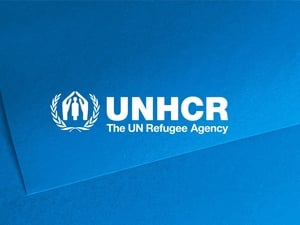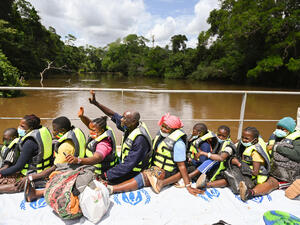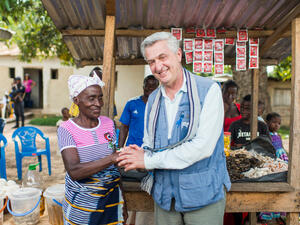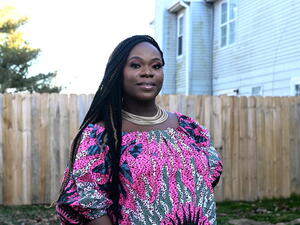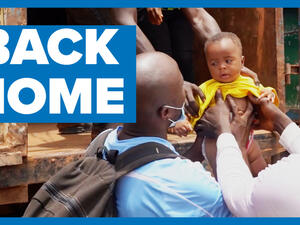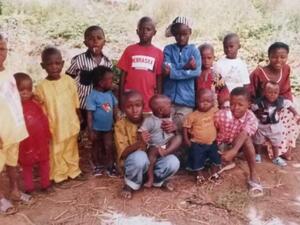UNHCR expands activities to help Liberian IDPs realise their goal of a new school
UNHCR expands activities to help Liberian IDPs realise their goal of a new school

UNHCR is helping former IDPs to rebuild a school in Balama, Liberia.
BALAMA, Liberia, 2 Feb (UNHCR) - Young men sweat under a merciless midday sun to build a new school in record time, demonstrating both UNHCR's expanding efforts to reintegrate internally displaced Liberians and the importance of letting communities decide their own priorities.
The volunteers handing bricks one by one to their companions are former internally displaced persons (IDPs) who recently returned to their forest village of Balama, home to some 3,500 residents in Liberia's central Bong County.
Balama needs more than a school; it was destroyed in 2002 during Liberia's 14-year civil war that ended in 2003. But the community, responding to the demands of the children themselves, decided that rebuilding their school was the priority. They want to finish it as quickly as possible so their children and those of neighbouring communities can study nearby.
As part of UNHCR's voluntary repatriation programme for Liberian refugees that started in October 2004, the UN refugee agency has been involved in a wide range of reintegration activities to help returnees, IDPs and the local community rebuild their lives. Special Community Empowerment Projects (CEPs), such as the primary school in Balama, is one of them.
This year Liberia has also been chosen for one of three UNHCR pilot projects providing protection and assistance to internally displaced persons, who face many of the same challenges as those who crossed a border to become refugees. Under the umbrella of the UN Emergency Relief Coordinator, the refugee agency - which was originally founded to help those fleeing outside their own countries - has taken the lead role in three areas of activity covering protection, camp management and shelter.
The communities usually decide their own priorities and then request UNHCR assistance. The projects are then carried out by UNHCR's implementing partners. In Balama, where the UNHCR partner American Refugee Committee is helping, building a school was a remarkable display of local decision making.
"We returned in November 2004 only to find our whole town destroyed," said John Golokay, the town chief. "Before the war, we had a school, but the rebels burnt it. So we had to start at square one to rebuild the place.
"When it came to decide on which CEPs we should engage in, I called for a clinic and a palaver hut," he said. "We held a meeting with the group of elders, the women and the residents. Everybody agreed. But the children complained," he said with a smile. "They wanted a school close to their homes.
"They said they were tired of having to get up at 5 am in the morning and walk for miles to reach the nearest school. They kept on insisting so much, complaining to their parents and coming back to our committee that we had to do something!" After three further meetings, the elders agreed.
"After all, children are our future," said Kerkulah Kerkar, the chief elder. "Considering all they went through we thought we could not deny them their request. But of course, initially it was surprising to us that they dared to question our proposals."
In the end, Balama's children won the fight not only for themselves, but also for children in 10 nearby villages. Seeing the school rise, the decision committee now seems satisfied and proud.
Once UNHCR agreed to fund the construction and provide the school with locally made furniture, everybody came together to help. Balama's women started making bricks while young men volunteered to do the building. They rotate to have enough time for their own farms and families. Golokay says the government has responded positively to a request for teachers.
"That's what community empowerment is all about," said Robert Tolbert, UNHCR field officer in Gbarnga. "IDPs are very enthusiastic about rebuilding because they have been here during the war. They know the situation in the country and they want to move on with their lives."
UNHCR reintegration programmes help all Liberians in major areas of return. But in Balama's case, 95 percent of returning Liberians are former IDPs and returning refugees because only five percent of the population stayed during the war.
Since the relocation of IDPs started in November 2004, UNHCR has assisted over 282,000 of 314,000 IDPs to return to their places of origin. In coordination with other UN agencies, UNHCR provides protection, non-food items and a cash grant to travel back to their home districts.
However, UNHCR urgently needs US$13.7 million to continue its return, reintegration and protection assistance to remaining IDPs in Liberia. A special appeal for donors has been launched within the Liberia Humanitarian Appeal.
Since Liberian President Ellen Johnson-Sirleaf came to power last month, activity seems to have accelerated. Africa's first female head of state put the return of IDPs and refugees atop her agenda and encouraged all Liberian's to join in rebuilding their nation.
Liberian's are regaining confidence in a peaceful future. Construction of the school, which will also take pre-school children, will soon be finished. The children are impatient to inaugurate their new institution; as we left for Monrovia youngsters from Balama waved, laughed and held up their fingers in the sign for victory.
By Annette Rehrl in Balama, Liberia


